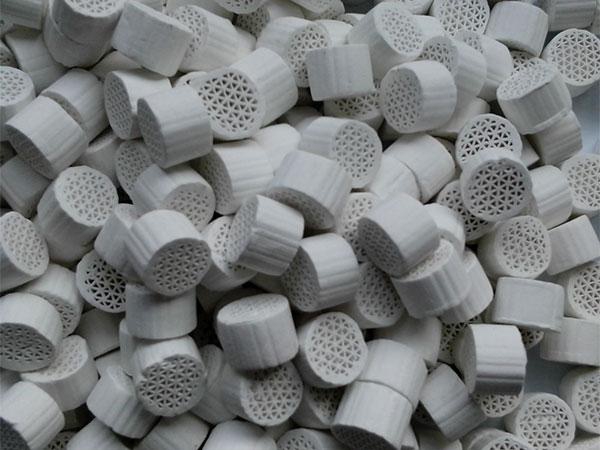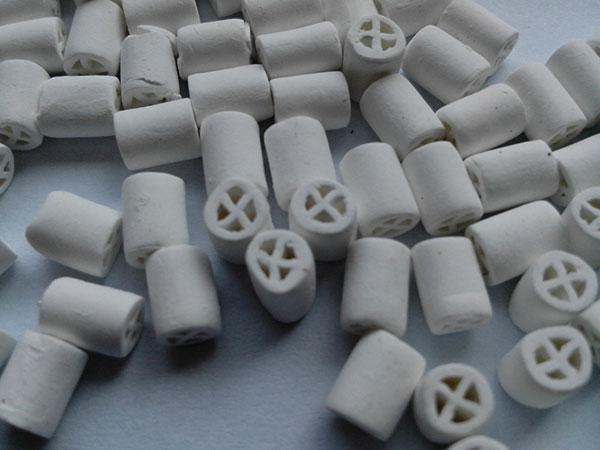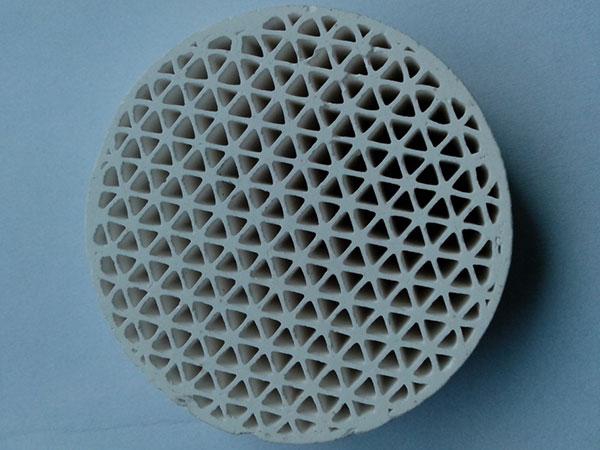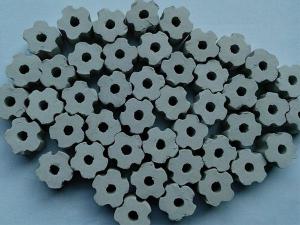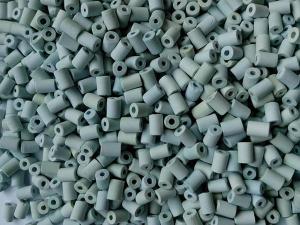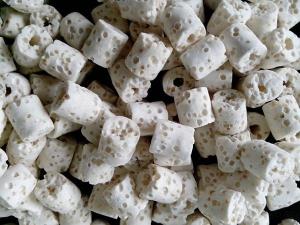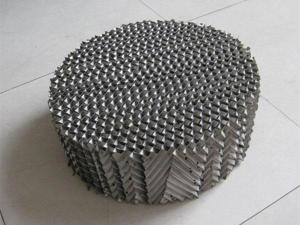Honeycomb ceramic catalyst support media are a new type of environmentally energy-saving product which completely replace the ceramic ball and hole ceramic ball. The raw material of the ceramic catalyst support media is high-purity alumina and pseudo-boehmite. Fired under high temperature, the guard bed media provide excellent characteristics, such as high strength, large specific surface and high porosity, thus effectively sharing the weight of other beds in the tower.
The honeycomb ceramic catalyst support media have a much greater porosity than the porcelain ball, allowing the gas stream to flow through the reactor cover and the support layer at a slower flow rate, mixing the mix thoroughly, and effectively lowering the bed pressure drop. Therefore, honeycomb ceramic catalyst support media have advantages that the ceramic ball cannot compare, regardless of energy saving and running time.
According to user requirements, we produce ceramic catalyst support media with different aluminum contents (20-95%). Product models include Φ3mm, Φ6mm, Φ10mm, Φ13mm, Φ16mm, Φ19mm, Φ25mm, Φ47mm and so on.
Because of its unique round design, the contact form is either a point or line, thereby effectively improving the dirt removal rate and further improving the horizontal distribution of gas and liquid, with porosity rising to 80% or more.
Attractive Features of Honeycomb Ceramic Catalyst Support Media
1. Reduce Pressure Drop
Catalyst support balls have a huge porosity and bed section opening area, 80% -100% higher than the porcelain ball, which thus reduces the pressure conditions. In particular, the longer the run time is, the more impurities accumulate, the more outstanding performance of the honeycomb ceramic catalyst support media will have. In comparison to traditional catalyst support balls, the honeycomb ceramic media can reduce the pressure drop by 40-50% or more.
2. Uniform Distribution
The honeycomb ceramic catalyst support media supports the bed from the bottom of the cross section. The opening area is 1.5-2.5 times that of the porcelain ball, so the ceramic ball pressure difference is much larger than the honeycomb ceramic support media. Stronger pressure and uneven distribution will easily cause uneven reaction, excessive reaction, precipitating, coking, and shorter lifespan of catalyst.
3. Improve Crushing Strength
Honeycomb ceramic catalyst support media is one part of porcelain bed, open hole surface equivalent value of 2.5-3.5 times, so under the same conditions in the same tower and the reaction noise is also lower than the ball 60% -70%. The honeycomb ceramic media has much smaller fluid pulsation under the same flow rate and the same fluid than the porcelain ball. Besides, the honeycomb ceramic catalyst support media has a dense network and a large specific surface area. The fluid is divided into small blocks to digest uneven pulsation and turbulence in the fluid so that the pulsation is more uniform and the crushing strength is improved.
At the same time, the heat exchange rate in the reactor is increased. And the slightly uniform pulsation improves the catalyst activity and doesn't impact the strength. It not only improves the catalytic reaction speed, but also ensures that the catalyst will not undergo premature precipitating and coking. The catalyst support media extend the life of the catalyst, improve the production cycle, increase production efficiency and reduce the cost of refining, finally increasing the economic efficiency of enterprises.
4. Filter Impurities (Inert & Active Impurities)
In the reaction system, impurities will gradually move down and eventually enter into the heat exchanger. This movement will affect the heat transfer efficiency, increase energy consumption and impact pulse and turbulence. After using the honeycomb ceramic catalyst support media, more than 95% of inert impurities and active impurities will be filtered.
5. Reduce Load to Bed
The normal use of porcelain ball is 1.5-2.0 tons/m3, while that of cellular ceramic pulse proppant is only 0.80-1.40 tons/m3, which is less than the porcelain ball and greatly reduces the load of the bed.
Brand No.: FW-01
| Index | Unit | Value |
| Alumina Content | % | > 90 |
| Temperature Change | ℃ | -20-800 |
| Max. Using Temperature | ℃ | 1350 |
| Acid Resistance | % | > 99 |
| Alkali Resistance | % | > 98 |
| Water Adsorption | % | <10 |
| Size | Specific Area, m2/m3 | Void Ratio, % | Average Compressive Strength Axial (KN/particle) Lengthways (KN/ Particle) | Bulk Density, t/m3 |
| Ф47 ×1 8 | 1500-1550 | 70-75 | > 10.0 | 0.6-0.75 |
| > 1.2 | ||||
| Ф25×13 | 1500-1550 | 70-75 | > 9.0 | 0.6-0. 8 |
| > 0.9 | ||||
| Ф18×10 | 1500-1550 | 70-75 | > 6.0 | 0.95-1.10 |
| > 0.75 | ||||
| Ф13×10 | 1600-1650 | 70-75 | > 4.5 | 1.00 -1.15 |
| > 0.65 | ||||
| Ф9× 6 | 1650-1700 | 70-75 | > 3.0 | 1.15 -1.25 |
| > 0.55 | ||||
| Ф6× 6 | 1650-1700 | 65-70 | > 2.0 | 1.20 -1.30 |
| > 0. 3 | ||||
| Ф4 × 5 | 1650-1700 | 65-70 | > 1.2 | 1.20 -1.35 |
| > 0.20 |
N/B: Different alumina content leads to different bulk density.
You may also find products like:
Catalyst Support Ball, Guard Bed Media, Ceramic Catalyst Support Media

